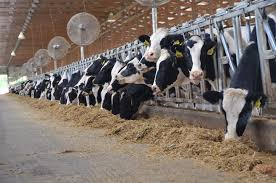Biology > Animal Husbandry > Dairy Management
Dairy management is the management of animals for milk and its products for human consumption. The main aim of dairy management is to deal with processes and systems that increase yield and improve the quality of milk.
Cattles are to be well looked after. Quantity and quality of cattle feed should be maintained. Cleanliness and hygiene of cattle, handlers, milk and milk products should be maintained. Cleanliness and hygiene should be maintained during storage and transport of milk and mil products. The process should be mechanised to avoid direct contact with handlers. The shed must be clean, spacious with adequate facilities for feeding, watering, and light. Identification of health problems, diseases, and rectification by veterinary doctors is mandatory. Cows and buffaloes are the main dairy animals reared for obtaining milk.

Selection of Breed:
The milk yield of dairy animals depends on the breed of the animal. The animals should be high yielding, disease-resistant and adjusting to the climatic conditions of the place where they are reared.
Animal Shelter (shed):
Animals should be protected from too much heat, rain, and cold. Hence proper shelter should be provided to them. The shelter should have a roof, proper sanitation, and ventilation. The floor should be cemented and should have a slight slope so that the drainage of urine takes place and cleaning of dung is efficient. Different types of animals should be kept separately. Too many animals should never be kept in a small space.
Animal Feed:
The cattle feed consists of two components a) roughage and b) concentrates. The main feed of cows and buffaloes are grass but this does not provide them with all the nourishment. The roughage (Silage) is fibrous food containing a large amount of fibres such as hay fodder, leguminous plants-soybeans, peas and cereals like maize, jowar, etc. and concentrates are grains, oil cakes and seeds, mineral salts and vitamins, cereal like bajra, gram, rice polish, etc. Roughage has less nutritive value while concentrates are rich in nutrients. An average Indian cow eats about 15-20 kg of green fodder and 4 to 5 kg dry grass, which is mixed with a sufficient amount of grain. A cow drinks about 32 litres of water. The diet of animals should be balanced and its vary with age, state, health, breed type, etc.
Water and its Supply:
To keep these animals healthy they should be given clean water to drink and in sufficient quantities. For example, on average, a cow consumes about 27-36L of water. The drinking water supply should be permanent. If the continuous drinking water supply is not available, dairy cows and buffaloes should be provided with water at least 3 times in summer and 2 times in winter. We must bathe the cattle with clean water. There should be enough water to clean the sheds and animals.
Animal Grooming:
The animals should be cleaned, washed and brushed regularly to avoid skin infections.
Diseases of Animals:
- Viral diseases: Pox in cattle, goats, and sheep; dermatitis in goats and sheep; foot and mouth disease in cattle, blue tongue
- Bacterial diseases: Tuberculosis in cattle; diphtheria in calf; footrot in sheep. mastitis. Anthrax, Hemorrhagic septicemia (due to infection (Pasturella multocida), Black quarter (due to infection of Clostridium chanroei), etc.
- Protozoan Disease: Trypanosomiasis
- Fungal Disease: Ringworm
- Other Diseases in Animals: Anthrax, tuberculosis, salmonellosis, mastitis, rinderpest (cattle plague), coccidiosis,
- External Parasites: lice, fleas, ticks, and mites. A buffalo leech (Hirudinaria granulosa) sucks blood of buffalo and causes anemia.
- Internal Parasites: worms (Ascaris rituloram) affects the stomach and intestine of cows and buffaloes and flukes (Fasciola gigantica and F.hepatica) damage the liver.
Most of these diseases can be prevented by proper sanitation, a controlled diet, proper housing and also by vaccinating the animals against these diseases at the proper time and age. The diseases can be cured by using proper antibiotics. External parasites can be controlled by applying dilute solutions of insecticides like lindane. A veterinary doctor should check farm animals regularly and the record of each animal should be maintained.
Animal Breeding:
Breeding means to reproduce. In the case of animals, breeding is done to obtain animals with desired characters. The two individuals of desirable characters can be selected as parents. These are then crossed to obtain new breeds of animals.
Artificial insemination is an important and effective method of breeding. The process involves injecting the semen obtained from desired bull belonging to high milk yielding breed into the reproductive tract of the female during heat period. It generally gives important breeds and is widely used to improve the qualities of cow, poultry, horse and goat etc
In India, improved breeds of dairy cows have been developed at National Dairy Research Institute (NDRI), Karnal, Haryana. Some examples are: Karan Swiss (Crossbreed of brown Swiss and Sahiwal), Karan Fries (Crossbreed of Tharparkar and Holstein-Friesian), Frieswal (Crossbreed of, Holstein-Friesian and Sahiwal)
Breeds in Dairy Management
Breeds of Cows:
Milch and Dairy Breeds:
- They are high milk yielding varieties. Bullocks of this variety are not useful as the work animal.
- Examples: Gir, Sindhi, Sahiwal, Gir, Deoni. Sahiwal is a superior breed in all breeds.
Draught Animals:
- The males of these categories are strong and sturdy. They are used for transport, pulling carts and ploughing in farms. The females of this variety give a little amount of milk.\Examples: Malir, Nageri, and Hallikar
Dual Purpose Breed:
- These breeds serve the purpose of above two breeds. The cow gives a moderate amount of milk and the bullocks are used for drought purpose.
- Examples: Tharparker, Kankrej, and Dang
Exotic Breeds:
- These breeds are not native to India. They are Jersey, Brown Swiss, Holstein.
Breeds of Buffaloes:
- Murrah gives 1800-2500 litres of milk every year. Mehsana gives 1200-2500 litres milk per year. Surti gives 1600-1800 litres of milk every year.
- Other well-known breeds of Indian buffaloes are Nagpuri, Bhadawari, Nili, Ravi.
Previous Topic: Breeds of Cows and Buffaloes